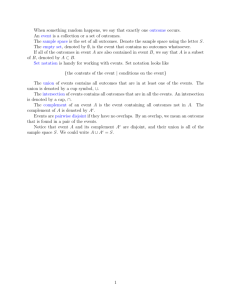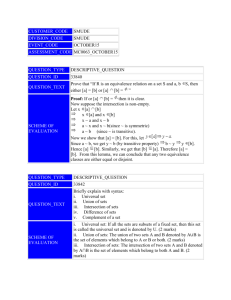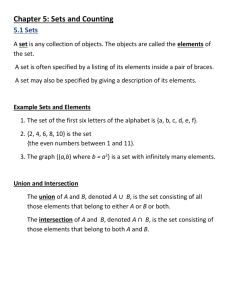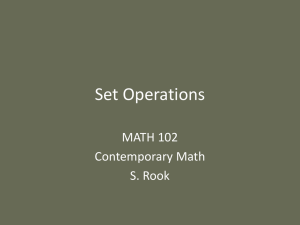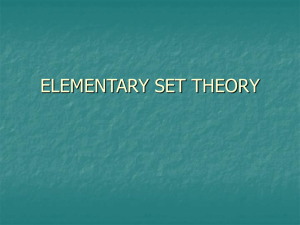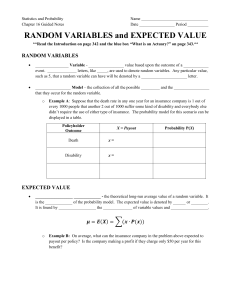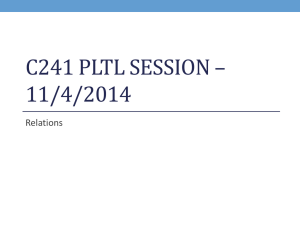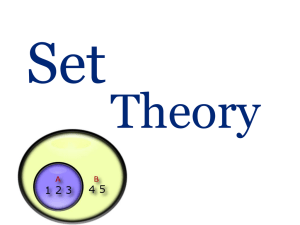MC0063A01
advertisement
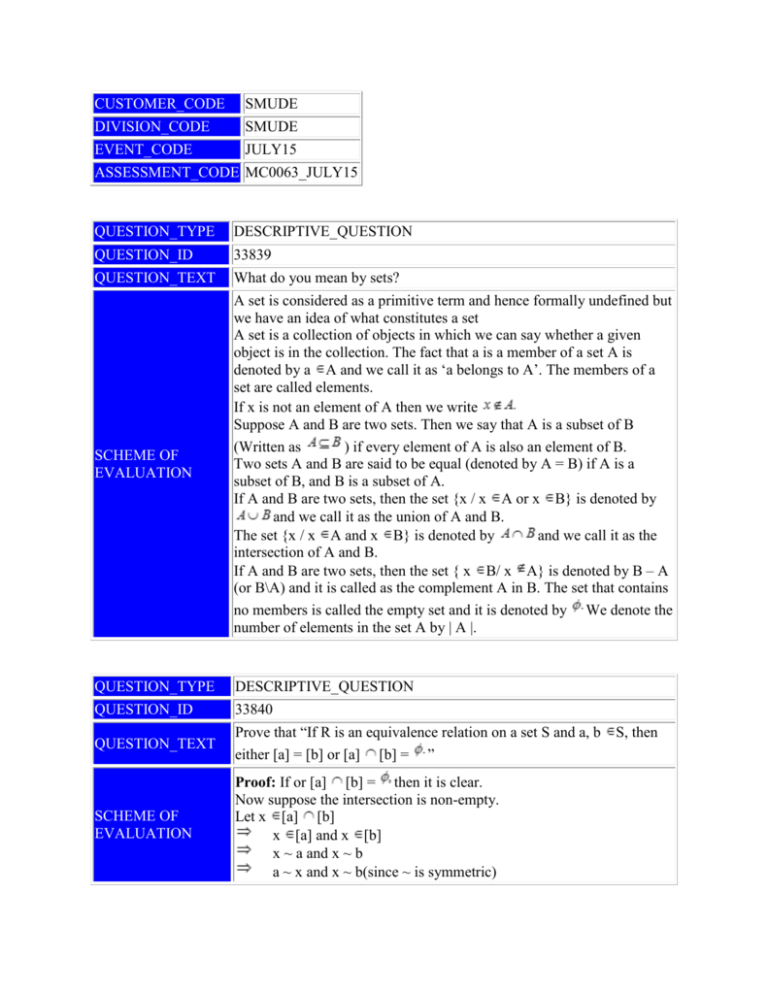
CUSTOMER_CODE
SMUDE
DIVISION_CODE
SMUDE
EVENT_CODE
JULY15
ASSESSMENT_CODE MC0063_JULY15
QUESTION_TYPE
DESCRIPTIVE_QUESTION
QUESTION_ID
33839
QUESTION_TEXT
What do you mean by sets?
SCHEME OF
EVALUATION
A set is considered as a primitive term and hence formally undefined but
we have an idea of what constitutes a set
A set is a collection of objects in which we can say whether a given
object is in the collection. The fact that a is a member of a set A is
denoted by a A and we call it as ‘a belongs to A’. The members of a
set are called elements.
If x is not an element of A then we write
Suppose A and B are two sets. Then we say that A is a subset of B
(Written as
) if every element of A is also an element of B.
Two sets A and B are said to be equal (denoted by A = B) if A is a
subset of B, and B is a subset of A.
If A and B are two sets, then the set {x / x A or x B} is denoted by
and we call it as the union of A and B.
The set {x / x A and x B} is denoted by
and we call it as the
intersection of A and B.
If A and B are two sets, then the set { x B/ x A} is denoted by B – A
(or B\A) and it is called as the complement A in B. The set that contains
no members is called the empty set and it is denoted by We denote the
number of elements in the set A by | A |.
QUESTION_TYPE
DESCRIPTIVE_QUESTION
QUESTION_ID
33840
QUESTION_TEXT
Prove that “If R is an equivalence relation on a set S and a, b
either [a] = [b] or [a] [b] = ”
SCHEME OF
EVALUATION
Proof: If or [a] [b] = then it is clear.
Now suppose the intersection is non-empty.
Let x [a] [b]
x [a] and x [b]
x ~ a and x ~ b
a ~ x and x ~ b(since ~ is symmetric)
S, then
a ~ b (since ~ is transitive).
Now we show that [a] = [b]. For this, let
Since a ~ b, we get y ~ b (by transitive property)
b ~ y y [b].
Hence [a] [b]. Similarly, we get that [b] [a]. Therefore [a] =
[b]. From this lemma, we can conclude that any two equivalence
classes are either equal or disjoint.
QUESTION_TYPE
DESCRIPTIVE_QUESTION
QUESTION_ID
33842
QUESTION_TEXT
Briefly explain with syntax:
i. Universal set
ii. Union of sets
iii. Intersection of sets
iv. Difference of sets
v. Complement of a set
SCHEME OF
EVALUATION
i. Universal set: If all the sets are subsets of a fixed set, then this set
is called the universal set and is denoted by U. (2 marks)
ii. Union of sets: The union of two sets A and B denoted by A∪B is
the set of elements which belong to A or B or both. (2 marks)
iii. Intersection of sets: The intersection of two sets A and B denoted
by A∩B is the set of elements which belong to both A and B. (2
marks)
iv. Difference of sets: The difference of two sets A and B denoted
by A–B is the set of elements of A which are not the elements of B. (2
marks)
v. Complement of a set: The complement of a set A with respect to
the universal set U is defined as U–A and is denoted by AI or AC (2
marks)
QUESTION_TYPE
DESCRIPTIVE_QUESTION
QUESTION_ID
33843
QUESTION_TEXT
Explain:
i. Relation matrices
ii. Partial ordered sets
SCHEME OF
EVALUATION
i. Relation matrices: A relation R between the sets A1, A2 ….. An is a
subset of A1 x A2 x …. x An. This relation R is called n-ary relation. In
general, a relation means binary relation on a set S (5 marks)
ii. Partial ordered sets: A partially ordered set (Poset) is a set S with a
relation R on S which is reflexive, anti-symmetric and transitive. (5
marks)
QUESTION_TYPE
DESCRIPTIVE_QUESTION
QUESTION_ID
105712
Explain the working of the RSA cryptosystem.
QUESTION_TEXT
Suppose that we choose two random 150-digit prime numbers p and q.
Next, we compute the product n = pq and also compute
where is the Euler -function. Now we start
choosing random integers E until we find one that is relatively prime to
m; that is, we choose E such that gcd (E, m) = 1. Using the Euclidean
algorithm, we can find a number D such that DE = 1 (mod m). The
numbers n and E are now made public.
SCHEME OF
EVALUATION
Suppose now that person B (Bob) wishes to send person A (Alice)
a message over a public line. Since E and n are known to everyone,
anyone can encode messages. Bob first digitizes the messages according
to some scheme, say A = 00, B = 02, …, Z = 25. If necessary, he will
break the message into pieces such that each piece is a positive integer
less than n. Suppose x is one of the pieces. Bob forms the number
mod n and sends y to Alice. For Alice to recover x, she need only
compute
mod n. Only Alice knows D.
QUESTION_TYPE
DESCRIPTIVE_QUESTION
QUESTION_ID
105716
QUESTION_TEXT
Using the principle of mathematical induction show that 102n–1 + 1 is
divisible by 11 for all n N.
Let
Now
which is divisible by 11. Therefore
for some integer k. Consider
SCHEME OF
EVALUATION
Therefore
which is clearly divisible by 11.
Therefore
Therefore P(m+1) is divisible by 11.
Hence by the principle of mathematical induction P(n) is divisible by 11 for
all n.

